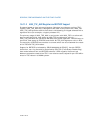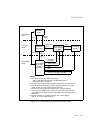
17-6 Vol. 3
8086 EMULATION
• Bit test and bit scan instructions BT, BTS, BTR, BTC, BSF, and BSR; the byte-set-
on condition instruction SETcc; and the byte swap (BSWAP) instruction.
• Double shift instructions SHLD and SHRD.
• EFLAGS control instructions PUSHF and POPF.
• ENTER and LEAVE control instructions.
• BOUND instruction.
• CPU identification (CPUID) instruction.
• System instructions CLTS, INVD, WINVD, INVLPG, LGDT, SGDT, LIDT, SIDT,
LMSW, SMSW, RDMSR, WRMSR, RDTSC, and RDPMC.
Execution of any of the other IA-32 architecture instructions (not given in the
previous two lists) in real-address mode result in an invalid-opcode exception (#UD)
being generated.
17.1.4 Interrupt and Exception Handling
When operating in real-address mode, software must provide interrupt and excep-
tion-handling facilities that are separate from those provided in protected mode.
Even during the early stages of processor initialization when the processor is still in
real-address mode, elementary real-address mode interrupt and exception-handling
facilities must be provided to insure reliable operation of the processor, or the initial
-
ization code must insure that no interrupts or exceptions will occur.
The IA-32 processors handle interrupts and exceptions in real-address mode similar
to the way they handle them in protected mode. When a processor receives an inter
-
rupt or generates an exception, it uses the vector number of the interrupt or excep-
tion as an index into the interrupt table. (In protected mode, the interrupt table is
called the interrupt descriptor table (IDT), but in real-address mode, the table is
usually called the interrupt vector table, or simply the interrupt table.) The entry
in the interrupt vector table provides a pointer to an interrupt- or exception-handler
procedure. (The pointer consists of a segment selector for a code segment and a 16-
bit offset into the segment.) The processor performs the following actions to make an
implicit call to the selected handler:
1. Pushes the current values of the CS and EIP registers onto the stack. (Only the 16
least-significant bits of the EIP register are pushed.)
2. Pushes the low-order 16 bits of the EFLAGS register onto the stack.
3. Clears the IF flag in the EFLAGS register to disable interrupts.
4. Clears the TF, RC, and AC flags, in the EFLAGS register.
5. Transfers program control to the location specified in the interrupt vector table.
An IRET instruction at the end of the handler procedure reverses these steps to
return program control to the interrupted program. Exceptions do not return error
codes in real-address mode.


















